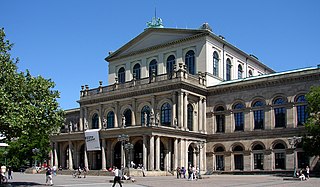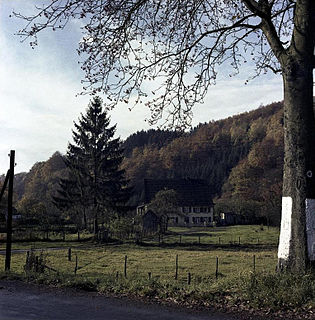Related Research Articles
Kontra-Punkte is a composition for ten instruments by Karlheinz Stockhausen which resolves contrasts among six instrumental timbres, as well as extremes of note values and dynamic levels, into a homogeneous ending texture. Stockhausen described it: "Counter-Points: a series of the most concealed and also the most conspicuous transformations and renewals—with no predictable end. The same thing is never heard twice. Yet there is a distinct feeling of never falling out of an unmistakable construction of the utmost homogeneity. An underlying force that holds things together—related proportions: a structure. Not the same Gestalten in a changing light. But rather this: various Gestalten in the same light, that permeates everything".
Kreuzspiel (Crossplay) is a composition by Karlheinz Stockhausen written for oboe, bass clarinet, piano and four percussionists in 1951. It is assigned the number 1/7 in the composer's catalogue of works.
Gruppen for three orchestras (1955–57) is amongst the best-known compositions of German composer Karlheinz Stockhausen, and is Work Number 6 in the composer's catalog of works. Gruppen is "a landmark in 20th-century music. .. probably the first work of the post-war generation of composers in which technique and imagination combine on the highest level to produce an undisputable masterpiece".

Trans is a composition for orchestra and tape by the German composer Karlheinz Stockhausen, written in 1971. It is Number 35 in the composer's catalog of works.

Jubiläum (Jubilee) is an orchestral composition by Karlheinz Stockhausen, work-number 45 in the composer's catalogue of works.
Adieufür Wolfgang Sebastian Meyer is a composition for wind quintet by Karlheinz Stockhausen composed in 1966. It is Number 21 in the composer's catalog of works, and the second of Stockhausen's three wind quintets.

Refrain for three players is a chamber music composition by Karlheinz Stockhausen, and is number 11 in his catalog of works.

Atmen gibt das Leben, is a choral opera with orchestra by Karlheinz Stockhausen, written in 1974 and expanded in 1976–77. It is Number 39 in the catalogue of the composer's works, and lasts about 50 minutes in performance.
The Konkrete Etüde is the earliest work of electroacoustic tape music by Karlheinz Stockhausen, composed in 1952 and lasting just three-and-a-quarter minutes. The composer retrospectively gave it the number "1⁄5" in his catalogue of works.

Punkte (Points) is an orchestral composition by Karlheinz Stockhausen, given the work number ½ in his catalogue of works.

Harlekin (Harlequin) is a composition for unaccompanied clarinet by Karlheinz Stockhausen, named for the commedia dell'arte character Harlequin. It was composed in 1975 and is Number 42 in his catalogue of works. A shorter, derived work called Der kleine Harlekin is Number 42½.

Stop is a composition for orchestra by Karlheinz Stockhausen, work-number 18 in the composer’s catalogue of works, where two performing realisations are also found as Nr. 18½ and Nr. 18⅔.

Ylem is a composition by Karlheinz Stockhausen for a variable ensemble of 19 or more players, and is given the work number 37 in his catalogue of compositions.

Herbstmusik is a music-theatre work for four performers composed by Karlheinz Stockhausen in 1974. It is Nr. 40 in his catalogue of works, and lasts a little over an hour in performance.
Schlagtrio is a chamber-music work for piano and two timpanists composed by Karlheinz Stockhausen in 1952. It is Nr. ⅓ in his catalogue of works.

The Sonatine (Sonatina) for violin and piano is a chamber music composition by Karlheinz Stockhausen, written while he was still a student in 1951. It carries the work-number ⅛ in his catalogue of works.
Drei Lieder, for alto voice and chamber orchestra, is a song cycle by Karlheinz Stockhausen, written while he was still a conservatory student in 1950. In the composer's catalogue of works, it bears the number 1/10.
Spiel is a two-movement orchestral composition by Karlheinz Stockhausen, written in 1952. Withdrawn by the composer after its first performance, it was later revised and restored to his catalogue of works, where it bears the work-number ¼. The score is dedicated to the composer's first wife, Doris.
Chöre für Doris, after poems by Paul Verlaine, is a three-movement a cappella choral composition by Karlheinz Stockhausen, written in 1950 and later given the number 1/11 in the composer's catalogue of works. The score is dedicated to the composer's first wife, Doris Stockhausen, née Andreae.
"Choral" (Chorale) is a short a cappella choral composition by Karlheinz Stockhausen, who wrote both the words and music in 1950. It was later given the number 1/9 in the composer's catalogue of works and lasts about four minutes in performance. The score is dedicated to the composer's first wife, Doris Stockhausen, née Andreae.
References
- 1 2 Stockhausen 1978, p. 51.
- ↑ Maconie 2005, pp. 63, 83.
- ↑ Kurtz 1992, p. 184.
- ↑ Maconie 2005, pp. 63–64.
- ↑ Frisius 2008, p. 42.